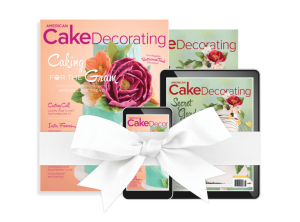This beautiful sugar quilling tutorial from Rebekah Naomi Cake Design takes inspiration from paper-quilled Holiday cards. Rebekah notes, “I love delicate and intricate paper-quilled designs, they lend themselves so easily to sugar-art. I added hand-written wafer paper sheet music to the design to accentuate the seasonal feel of the cake.” This versatile and easy technique could be re-purposed to create a multitude of different designs.
Components:
- Non stick cutting mat (plastic cutting board)
- Pair of sharp scissors
- Small rolling pin or a pasta roller
- Vegetable shortening
- Gumpaste colored in your choice of gel colors
- Food storage bags
- Small paintbrush
- Water for gluing or edible glue
- Sharp knife or ribbon cutter
Color all your gumpaste ahead of time and store each color in a food storage bag to keep it pliable.
Choose a design for your inspiration, here I chose a Christmas holiday card and used this to create the elements in my design.
Step 1) Roll out your dark green gumpaste to a uniform thickness (approx. 2mm), use a small amount of vegetable shortening to prevent sticking and allow easy rolling, alternatively you can
also use a dusting of cornstarch, though this will make the gumpaste dry a little faster.
An excellent way to roll out gumpaste to a uniform thickness is by using a pasta roller. I recommend rolling to a number 2 or 3 setting.
Step 2) Lay your gumpaste onto a non stick mat, immediately after rolling the gumpaste is very soft and well conditioned which makes it a little more difficult to work with, leaving the paste to air dry for a few minutes will allow cleaner cutting and easier workability.
Step 3) Using a sharp knife or a ribbon cutter, cut the gumpaste lengthways into even strips (1cm in width) remembering that the thinner the ribbons the more delicate the design will appear, additionally thicker and wider ribbons create heavier pieces.
Step 4) Take one dark green ribbon and lay flat, using a small amount of water, gently brush the top side of the ribbon and lay a light green strip directly over the top. Gently apply a small amount of pressure to firmly glue the ribbons together and trim the ends.
Step 6) Fold the whole ribbon over on itself lengthways to create a ribbon of double thickness, place the ribbon on it’s side and manipulate into a curl, spiraling one end in on itself, as shown in the above picture.
Repeat this process, varying the curvature and length of your spiral pieces until you have created 3 or 4 curled gumpaste ribbons.
Step 7) To create the holly leaves, take a long ribbon of the gumpaste, cut it in half width-ways, taking both ends, fold them inward until they meet in the middle and trim off the excess.
Step 8) Pinch the middle where the two ends meet to create a heart shape, repeat this process several times shortening the length of gumpaste each time by a small amount so that each heart becomes gradually
smaller.
Pinch the middle where the two ends meet to create a heart shape, repeat this process several times shortening the length of gumpaste each time by a small amount so that each heart becomes gradually
smaller.
Lay the hearts on their side edge and arrange in a leaf shape, leaving space between each piece and allow to fully air dry.
Step 9) To create the poinsettia, roll out the red gumpaste to a uniform thickness of 3 mm and cut ribbons again 1cm wide. Leave the gumpaste to air dry again for several minutes, this is especially important when you have used a large amount of gel paste to color your gumpaste.
Take a length of the gumpaste and coil it around into a spiral circle. Repeat this process until you have 5 even sized circles.
Take another length of gumpaste, fold it in half width ways to create a double thick layer and wrap it around the circle, pinching the end to create the point of the flower and then using the scissors to trim the end and create the other point.
I wrapped an additional white layer of paste around each of the petals, which I later painted gold, but you don’t have to include this in your design. I created a second inner layer using the same technique as for the leaves but with the red gumpaste, this creates a fuller and more aesthetically pleasing flower.
Arrange the flower on your mat and allow it to fully dry. When the decorations are completely dry (which takes 24-48) hours depending on the humidity of your location, take some time to arrange them on your mat. Arranging the decorations ahead of time allows you to create a cohesive design that can then be easily attached to your finished cake. Measuring the
height of your cake can be extremely helpful in this step.
When your cake is decorated, leave the fondant to set overnight before applying the decorations. They are heavy and need a dry surface to adhere to.
You can attach the decorations with melted white chocolate and set the chocolate with a cold food safe freezing spray. Once the chocolate is set the decorations are well supported.

















